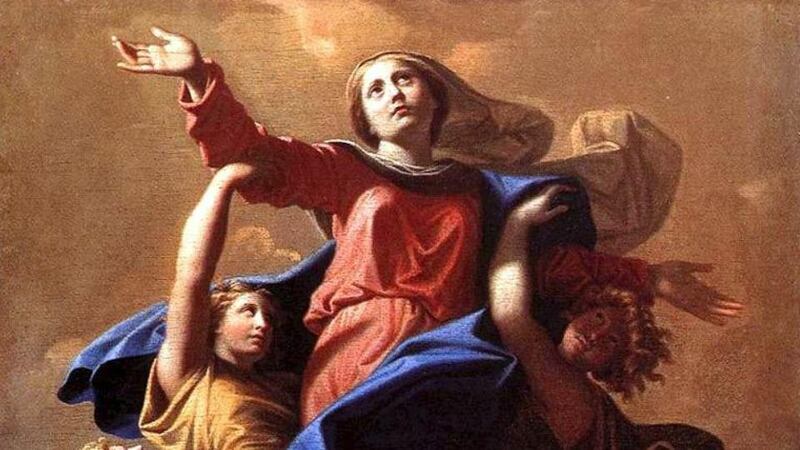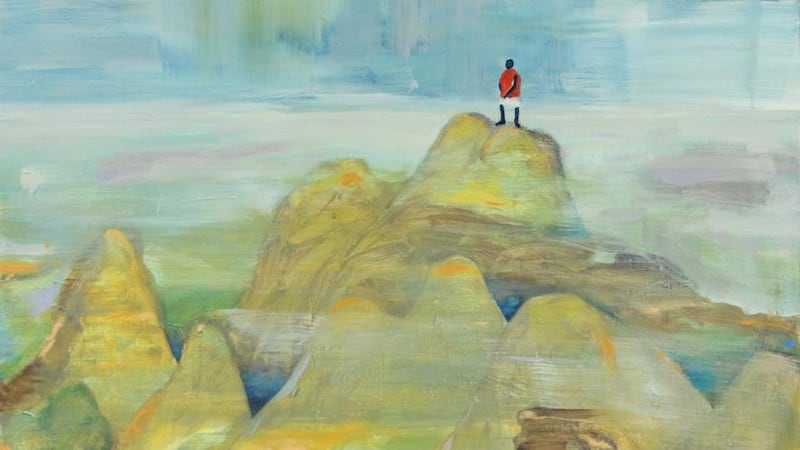The title of Robert Armstrong's exhibition at the Kevin Kavanagh Gallery in Dublin, Assumptions, is loaded. What's being assumed, and by whom? Lots, by everybody, the paintings suggest.
The immediate reference is to a painting by Poussin, The Assumption of the Virgin, completed in 1650. Borne by a group of muscular, purposeful angels, the Virgin ascends towards the heavens. A warm light suffuses the clouds above.
Armstrong's painting Assumption is recognisably related to the Poussin in terms of palette, composition, energy and even some visual detail. Yet much of the grammar of Armstrong's painting is abstract. It is as if the Poussin has been fast-forwarded several centuries, emerging from its time-travelling in a different, transformed state. Strangely enough, something like the same effect was evident in the space of Poussin's own lifetime.


The 1650 Assumption is his second major treatment of the subject. It's quite different from the first, which he completed during his early years in Rome. That painting is so awash with cute cherubs, and so much lighter in tone, that some scholars later refused to believe the Poussin they knew – famously measured and austere – could have painted it. As with other works, it was banished from the canon for a time. In many cases reattribution was correct, but the 1620s Assumption has been restored to the fold on the evidence of firm authentication.
As Konrad Oberhuber put it in his major study of the artist’s early career, in the painting Poussin takes the Baroque idiom he’d been exploring: “creams the surface . . . and loads it with sugar and raspberries”. It’s “the anticipation of French rococo”. Hardly surprising that many observers “could not believe that Poussin ever created anything so sweet. But he did.”
One can imagine Armstrong, who is both a practising artist and, as head of painting at the National College of Art and Design, an academic, relishing the historians’ dilemma. Their assumptions, you could say, were misplaced.
Unsurprisingly, the earlier Poussin also puts in an appearance in the exhibition, as do details and elements of several other works. But Armstrong is not playing an art-historical game whereby we can “solve” a painting of his by identifying a historical work to which it refers. He does like to look intently at paintings, finding things in them that overturn our assumptions about what we are seeing. Don’t listen to the scholar who tells you Poussin doesn’t do sweet, he seems to say – just look at the picture.
The picture, in the sense of the picture plane in painting, the surface that is infinitely available and malleable in just the way that Oberhuber's description of Poussin eloquently expresses it, clearly fascinates Armstrong. It can play out in subtle ways. In Kiribati Man a figure is perched atop a slice of dramatically hilly terrain. Presumably the hills are those on the island of Banaba, the sole piece of raised ground in a nation otherwise composed of 32 atolls.
Not only may virtually all of Kiribati disappear beneath the surface of the ocean as sea levels rise but, human nature being what it is, it is possible the only three-dimensional part of the nation, Banaba, faces another threat to its existence. Tiny as it is, it is rich in phosphate. Global warming and local political complications have ensured that Kiribati is being both engulfed and dismantled, to arrive at a point of stasis, a flat surface.
He doesn’t spell it out, but surely the saga appeals to Armstrong as a metaphor for the process of painting. He was born in Gorey, Co Wexford, where his father was a printer who ran his own workshop, and Armstrong put his early experience of typesetting and graphic design to good use. He studied painting at NCAD, although he also worked extensively in graphic design, producing posters, publications and illustrations for many years.
A founder member of Temple Bar Studios, he is still based there. It was almost surprising when he took up a position as lecturer at NCAD in the early 1990s, in that he was so distinctively a non-establishment figure. To this day he is not associated with the RHA, for example. There is no question but that he has been an influential presence at NCAD, where he has been head of painting since 2002. A quietly influential presence, it is important to say. As his work suggests, Armstrong is not a prescriptive – or, perish the thought, dictatorial – teacher in search of followers and imitators. Rather the underlying sceptical, quizzical and fairly good-natured quality that comes through in his work reflects his sensibility.
He tends to impart that to his students, it is surely fair to say, as well as something else: a genuine love for making things; for taking what’s given and transforming it; for coming up with something unforeseen – like Poussin turning sweet.
Assumptions is at the Kevin Kavanagh gallery, Dublin 8, until February 15th; kevinkavanagh.ie












